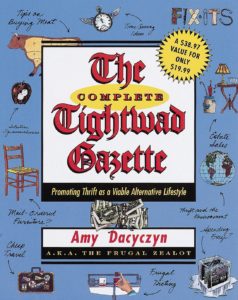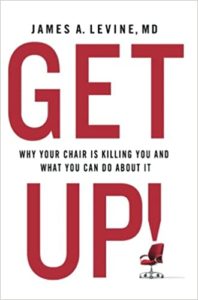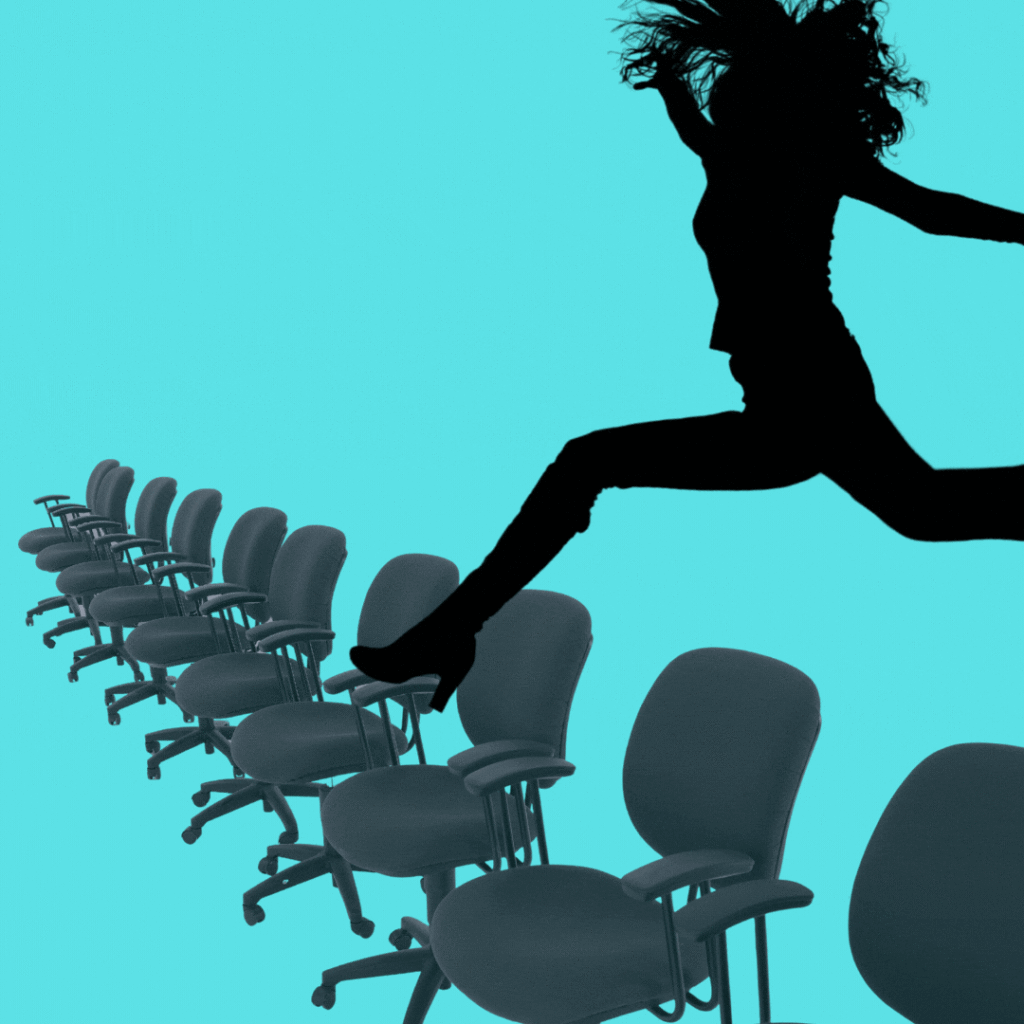This post was last updated on August 24th, 2023 at 08:00 am
Let’s start by discussing what you won’t find in this book list to inspire you to be more active. There are no “Fit in a Flash” titles here. Nothing about aerobics or cross training. Nothing about sports. In fact, none of the books are about exercise. I didn’t focus on this topic because there’s a difference between having an active lifestyle and exercising.
Many active people do exercise, and that’s great. I enjoy exercising, too. However, it is possible to exercise a lot and still live a sedentary lifestyle. Folks who fall into this category are known among researchers as “active couch potatoes.” They exercise but also sit for prolonged periods of time, ultimately negating some of exercise’s health benefits.
This book list—”Digital minimalism,” “The Complete Tightwad Gazette,” “Diary of an Early American Boy,” and “Get Up!—drives at the heart of what it means to be physically active and lead a frugalmatic lifestyle. Along with inspiring you, some of these books offer concrete ideas for moving more and sitting less. People who have active lifestyles are intentional about avoiding inactivity. They have a plan, and it doesn’t involve much sitting.
Having to worry about sitting too much is a relatively new phenomenon. Even up until the early 1800s, Americans were constantly on the move. They had active lifestyles without having to think about it. One of the books in this list, “Diary of an American Boy,” provides context for what life used to be like before Americans became sedentary. I include this book in my list as a reminder of just how quickly we’ve gone from using our hands to create the things to using our hands to swipe and tap computer screens to get whatever we need.
“Digital Minimalism: Choosing a Focused Life in a Busy World” by Cal Newport
Appropriately, I’m kicking off my list with a rebuke of our digital culture: “Digital Minimalism” by Cal Newport. Newport and I agree about the effects of social media/smartphones on people’s well-being. He doesn’t make it his mission to associate smartphones with sedentary living, but he clearly sees heavy social media use as a barrier to an active lifestyle.
Newport spends much of his book discussing an experiment he conducted in which he asked volunteers to give up their smartphones for 30 days. After this time, the volunteers could use their smartphones, though Newport asked them to limit their use to meaningful tasks. In particular, Newport encouraged the volunteers to give up social media. It was a struggle for many of them, but once they overcame the initial “withdrawal,” many of the volunteers reported that they preferred living without social media.
Read more about life without a smartphone

If you’re unwilling to give up social media, Newport recommends setting specific times during the week to review social media accounts on desktop computers. This way, you’re not constantly tempted to check your smartphone.
Newport also encourages people to develop a passion to fill the void they might feel after giving up their smartphones/social media apps. Newport spotlights people who live frugally and engage in large amounts of “strenuous leisure”—one being the author of one of my favorite blogs, Frugalwoods. On her site, Liz Thames details her family’s life on a 66-acre rural Vermont homestead. Her life is full of physical activity. “We spend the whole summer harvesting wood,” Thames told Newport. “You have to go into the forest, identify the trees to bring down, then you have to buck the logs, bring them on-site, split them, stack them, while also being careful to monitor the wood stove as it heats.”
I don’t think it’s a coincidence that Newport links digital minimalism, physical activity, and frugal living. Each supports the other. You must be intentional to achieve frugality and digital minimalism. And you likely won’t succeed at either without having an active lifestyle.
“The Complete Tightwad Gazette” by Amy Dacyczyn
Amy Dacyczyn’s book, comprising her popular newsletters published in the 1990s, details hundreds of ways to save money. What becomes clear in reading this 959-page volume of nuggets of advice and wisdom is that saving money often becomes a physical task. Whether Dacyczyn is describing how to make a Halloween costume, how to reuse old socks, how to garden, or how to cut boys’ hair, following her advice requires movement.
In one of her critiques on productivity, she notes that “I have found that a distinguishing characteristic of successful frugal people is that they tire rather quickly of nonproductive activities and long to do something that shows concrete results.”

She’s known as the Frugal Zealot, and her saving strategies are intense. They sometimes make me feel like a spendthrift. She published her newsletters at the dawn of the internet, long before smartphones arrived on the scene. Her best critique of technology is perhaps her piece “Taming the Tube.” She’s not anti-television by any means and believes TV can be a good source of cheap entertainment. At the same time, she understands how watching TV can waste time. “Two modern facts are often cited: People are incredibly busy these days, and the average adult watches 4.5 hours of television daily. I believe the second fact causes the first fact,” she writes. “To me, TV is like white sugar: The chief harm is not in the stuff itself but that it replaces good stuff.”
Today, the smartphone has replaced the TV as the device of choice for many people, especially among millennials and Gen Z. Dacyczn’s views on TV, however, could be easily applied to smartphones. Beyond limiting one’s productivity, these devices encourage sedentary lifestyles. Dacyczn identifies the same problem with TV. “Even if, like me, you try to keep busy while watching TV, there’s a limit on how active you can be and still watch,” she writes.
Learn about the health benefits of an active lifestyle
While some of the advice in Dacyczyn’s book is outdated, particularly the parts about the internet, the majority of it remains relevant. Like Newport’s “Digital Minimalism,” “The Complete Tightwad Gazette” isn’t explicitly about living an active lifestyle, but that’s essentially what the book does through its promotion of frugality.
“Diary of an Early American Boy” by Eric Sloane
This piece of historical fiction illuminates what life was like on a homestead. The book is based on an actual diary written in 1805. Eric Sloane found the diary at a local library book sale along with an inkwell initialed N.B. With his book, Sloane imagines the events and the lives referenced in the diary, centering on 9-year-old Noah Blake. Noah and his family’s daily routine is filled with activity, from sunrise to sunset. Whether they’re building a mill, making tools in the forge, pressing cider, or carrying water from their well—there’s hardly a moment of rest for the Blake family.
I included “Diary of an Early American Boy” in my reading list for its perspective on life not that long ago. As humans, we remained active for thousands of years until only about 200 years ago with the arrival of the industrial revolution. Sloane demonstrates his depth of knowledge of the settlement of the United States through both the written word and detailed pen-and-ink drawings. Yes, life on a homestead was difficult, and few people today would want to switch places with the Blake family, who worked constantly to ensure their survival and protection from the elements. Yet, it’s hard not to notice the rewards their lifestyle yielded, as they conquered challenge after challenge through their own ingenuity and persistence.
Get in touch with your inner-pioneer by using more hand tools

“In Noah’s time, nearly every single thing a person touched was the result of his own efforts. The cloth of his clothing, the meat on the table, the chair he sat in, and the floor he walked upon, all were made by the user. This is why those people had an extraordinary awareness of life,” Sloane writes. “They knew wood intimately; they knew the ingredients of food and medicines and inks and paints because they grew it and ground it and mixed it themselves. It was this awareness of everything about them that made the early American people so full of inner satisfaction, so grateful for life and all that went with it.”
Today, we struggle to find reasons to move at all, let alone make something with our own hands. Robotic technologies threaten to wipe out what few physically-demanding responsibilities we have left. Robots have started to vacuum floors, and now they’re mowing lawns. We don’t even need to get up to shop. With a click of an app, we can have groceries delivered. Each year, it seems like we have fewer reasons to get out of our chairs.
If we’re to start moving again, we cannot expect technology to save us. I’m not saying we should all set out to build cabins (because, for one, most of us probably wouldn’t know how). However, the past provides valuable insight into human nature and the source of satisfaction. While technology has rapidly evolved in recent years, human biology has not. We are basically the same creatures today as we were in 1805. It should be no surprise that our mental and physical health suffers when we become detached from our active roots.
“Get up!: Why your chair is killing you and what you can do about it” by James A. Levine, MD
For an academic and scientific critique of today’s “sitting disease,” as James Levine describes the sedentary lifestyle, “Get up!” lays bare the consequences of living in our chairs.
The problem isn’t that we sit—after all, humans have always sat. The problem is the quantity of sitting that we do. Sitting was meant to give us a respite after a long day of physical activity. Today, however, it’s become our default position. We no longer sit to take a break but sit because there’s no need to be active.
Levine’s book, published in 2014, didn’t predict the coronavirus pandemic, but he did predict its consequences. One of his chapters outlines a dystopian future in which people are permanently regulated to chairs, communicating with each other only remotely.
He envisions a typical day for a school child that’s eerily similar to what many families experienced in 2020. The child in this dystopian vision, named Chari, attends school virtually. “The virtual schooling system is superior to antiquated concrete systems because lessons are standardized, school buildings are unnecessary and all children have a nice, culturally sifted cohort of friends,” Levine writes.
Read my interview with Dr. James Levine

One of the reasons virtual school is embraced, he notes, is because “there are no transmissible diseases.”
Ultimately, Levine isn’t as pessimistic as the dystopian scenario suggests. He believes technology will play a role in encouraging people to be more active. Governments and public schools will need to step up their efforts to get people moving, he says.
I’m not as optimistic about the nation’s trajectory. Despite Americans becoming more aware of “sitting disease” and its effects, not enough people are motivated to do something about it.
However, there’s no reason you and I must succumb to “sitting disease.” We can be intentional about adding movement to our daily routine.
Use these books to grow your awareness
The first step to escaping a sedentary lifestyle is to become aware of it. Once you’re aware, it’s easier to become more physically active. These four books offer plenty of inspiration.
If you’re already feeling inspired, I invite you to grab your free digital copy of my Frugalmatic Starter Kit. It’s an easy way to begin adding movement to your daily routine, without having to completely upend it. The kit is designed to help you identify and act on opportunities to become more physically active but without the focus on exercise.

